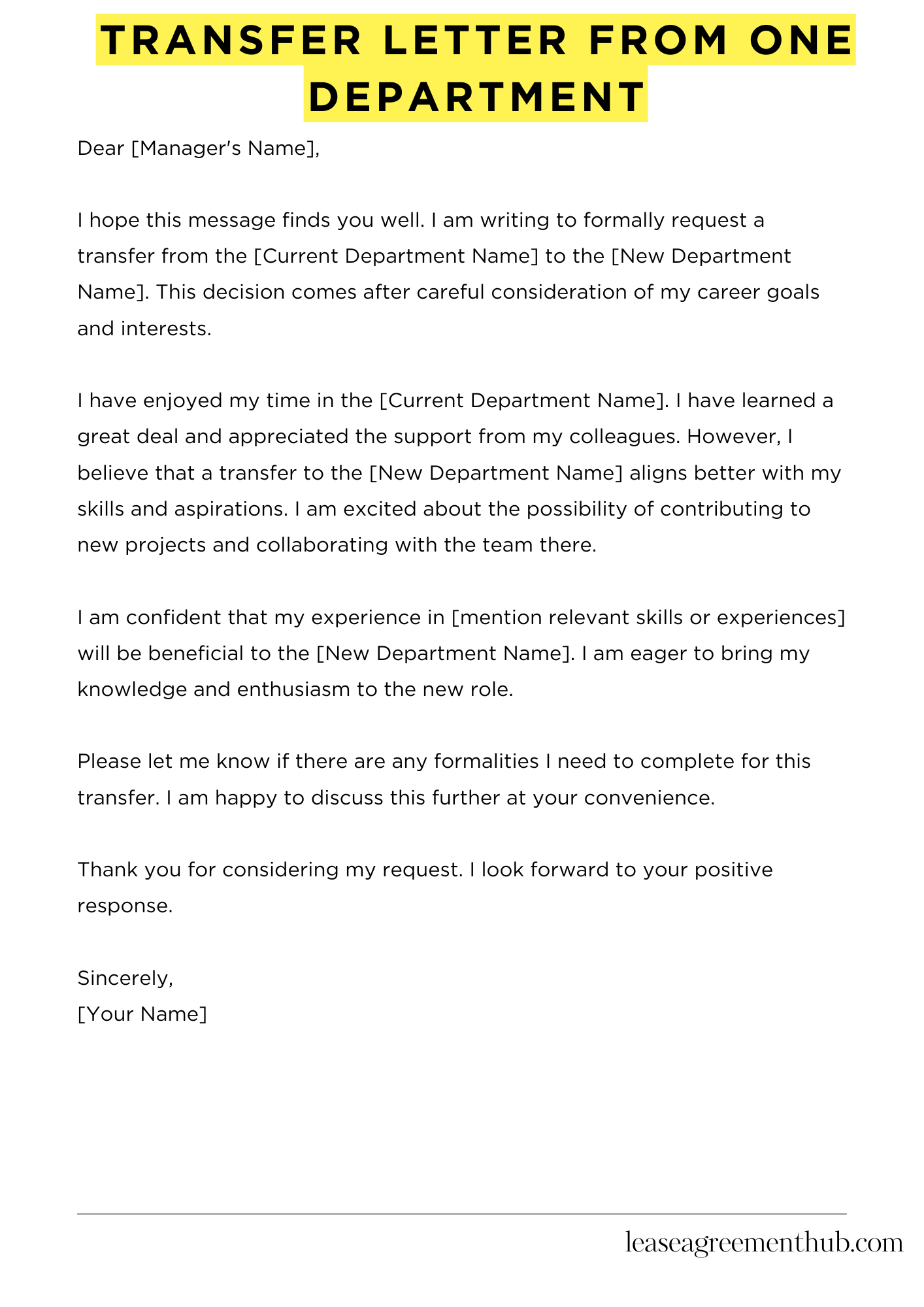A transfer letter from one department is a formal document that an employee uses to request a change in their work location within the same organization. Its purpose is to communicate the employee’s desire to move to a different department, often for reasons like career growth, skill development, or personal circumstances. This letter helps ensure that the transition is smooth and that all parties are informed.
In this article, we will provide various templates and examples of transfer letters from one department. These samples are designed to help you craft your own letter easily and effectively. Whether you are seeking a lateral move or a promotion, you will find useful formats to guide your writing process.
By using our templates, you can save time and avoid confusion. Each example is straightforward and tailored to different situations. With these resources, you can confidently express your intent to transfer and make a professional impression.
Transfer Letter From One Department
[Your Name]
[Your Address]
[City, State, Zip Code]
[Email Address]
[Phone Number]
[Date]
[Manager’s Name]
[Department Name]
[Company Name]
[Company Address]
[City, State, Zip Code]
Dear [Manager’s Name],
I hope this message finds you well. I am writing to formally request a transfer from the [Current Department Name] to the [New Department Name]. This decision comes after careful consideration of my career goals and interests.
I have enjoyed my time in the [Current Department Name]. I have learned a great deal and appreciated the support from my colleagues. However, I believe that a transfer to the [New Department Name] aligns better with my skills and aspirations. I am excited about the possibility of contributing to new projects and collaborating with the team there.
I am confident that my experience in [mention relevant skills or experiences] will be beneficial to the [New Department Name]. I am eager to bring my knowledge and enthusiasm to the new role.
Please let me know if there are any formalities I need to complete for this transfer. I am happy to discuss this further at your convenience.
Thank you for considering my request. I look forward to your positive response.
Sincerely,
[Your Name]

How to Write a Transfer Letter From One Department
Moving to a new department within your company can be an exciting step in your career. It allows you to explore new opportunities, learn new skills, and contribute to a different team. A well-written transfer letter is crucial for making a positive impression on your new department and ensuring a smooth transition. Here’s a step-by-step guide to help you craft a compelling and effective transfer letter.
1. State Your Intent Clearly
Begin your letter by stating your intention to transfer to the new department. Be direct and concise. For example, you could write: “I am writing to formally request a transfer to the [New Department Name] department, effective [Date].”
2. Highlight Your Relevant Skills and Experience
This is your chance to showcase why you’re a valuable asset to the new department. Focus on your skills and experience that align with the new role and responsibilities. Be specific about your accomplishments and quantify your contributions whenever possible. This will demonstrate your understanding of the new department’s needs and your ability to contribute effectively.
3. Explain Your Motivation for Transferring
Provide a clear and concise explanation of your reasons for wanting to transfer. This could include a desire to expand your skills, take on new challenges, or contribute to a specific project or initiative. Be genuine and enthusiastic, but avoid dwelling on negative aspects of your current department. Focus on the positive aspects of the new department and how you can contribute to its success.
4. Express Your Commitment to the Company
Reiterate your commitment to the company and your desire to continue contributing to its success. This demonstrates your loyalty and willingness to take on new challenges. You can also express your enthusiasm for the new department and your eagerness to learn and grow within the company.
5. End With a Professional Closing
Conclude your letter with a professional closing, expressing your gratitude for the opportunity to transfer and your willingness to discuss your request further. End with a polite closing, such as “Sincerely” or “Best regards,” followed by your name and contact information.
Remember to proofread your letter carefully for any errors in grammar or spelling. A well-written transfer letter can make a significant difference in your transition to a new department and your overall career success.
Related: